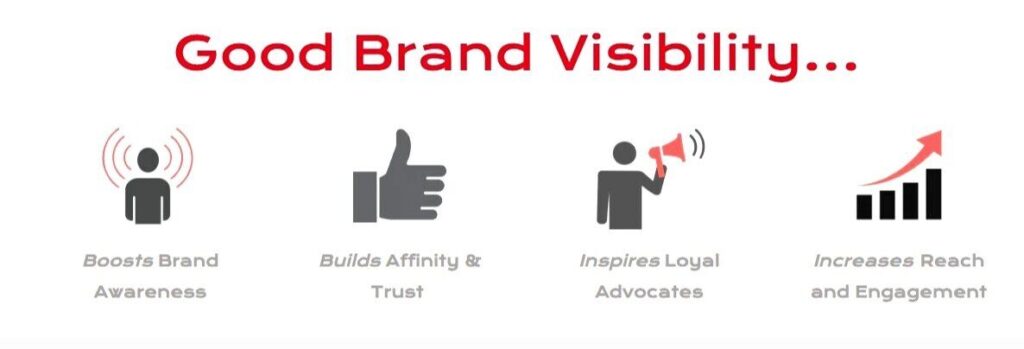Table of Contents
ToggleWhat are Share of Voice Tools?
A Share of Voice tool empowers brands to measure their presence by comparing it to competitors within the same market. These digital solutions provide data-driven insights and facilitate strategic decision-making.
Common functions include:
- Monitoring Media Mentions: Tracks brand mentions across various channels.
- Analyzing Competitor Activity: Evaluate how competitor brands perform in the same space.
- Audience Sentiment Analysis: Assesses public sentiment toward the brand and competitors.
- Identifying Opportunities: Finds gaps in market coverage for strategic action.
These tools are essential for maintaining competitive advantage and refining marketing efforts for enhanced brand visibility.
How does Brand Visibility drive business Growth?
Brand visibility is more than a critical marketing strategy; it’s the lifeblood of sustainable business growth. It represents the frequency and ease with which potential customers encounter your brand in their daily digital and physical lives. High visibility acts as a powerful growth engine by systematically building trust and shaping consumer behavior.

Image Source: Commpro
Brand visibility is a critical aspect of marketing strategy. High visibility allows a The Direct Link to Revenue: From Awareness to Advocacy
Substantial brand visibility directly fuels the customer journey, leading to tangible financial results. Here’s how:
- Increase Top-of-Funnel Awareness: You can’t convert a customer who doesn’t know you exist. High visibility ensures your brand is the one they recall when a need arises. For example, a consumer searching for “best running shoes for flat feet” is far more likely to click on and trust a brand name they recognize from ads, articles, and social media mentions.
- Foster Loyalty and Reduce Customer Acquisition Cost (CAC): When a brand consistently stays top-of-mind with valuable content and engagement, it builds an emotional connection. This loyalty transforms one-time buyers into repeat customers and brand advocates who refer others, effectively lowering the cost to acquire each new customer.
- Drive Consumer Preference and Command Premium Pricing: Frequent, positive visibility builds perceived authority and quality. In a side-by-side comparison, a visible brand will often win over a generic or lesser-known competitor, even at a slightly higher price. This “mental market share” allows you to protect your margins.
A Case in Point:
Consider a direct-to-consumer (DTC) furniture brand that focused heavily on creating high-quality tutorial content and engaging with interior design communities online. This increased their brand visibility far beyond their own website. When customers were ready to buy a new sofa, this brand was the first they thought of, leading to a 40% increase in direct traffic and a 15% reduction in their reliance on paid ads for sales.
Achieving Substantial Brand Visibility: A Multi-Channel Approach
This isn’t achieved by accident. It requires a disciplined, multi-faceted strategy:
- Consistent Messaging and Visual Identity: Cohesion in brand messaging, tone, and visuals across all channels—from your website to your social media to your packaging—creates a strong, memorable brand image that is easily recognized and trusted.
- Targeted Advertising and Strategic PR: Focused ad campaigns that reach the right audience segments, combined with earned media in relevant publications, build credibility and drive qualified visibility.
- Proactive Social Listening and Engagement: True visibility comes from dialogue, not monologue. Actively interacting on social platforms, responding to comments, and joining relevant conversations makes your brand feel present and responsive.
Effective brand visibility ensures a company doesn’t just exist in a crowded market—it stands out, builds trust, and actively amplifies business opportunities.
How Does a Share of Voice Tool Work?

Image Source: Semrush
A Share of Voice (SOV) tool is the engine that transforms vast amounts of online chatter into a clear, actionable measure of your brand’s visibility relative to your competitors. It operates through a sophisticated process of data collection and analysis, providing a factual basis for your marketing strategy.
The Operational Workflow: A Step-by-Step Breakdown
- Data Collection: The tool casts a wide net, using APIs and web crawlers to gather public mentions of your brand, competitors, and industry keywords across a multitude of sources: social media platforms (Twitter, Instagram, Reddit, TikTok), news sites, blogs, forums, and review sites.
- Keyword and Entity Monitoring: It tracks a predefined set of keywords, including your brand name, product names, campaign slogans, and competitor equivalents. Advanced tools use Natural Language Processing (NLP) to understand context, distinguishing between Apple the tech company and apple the fruit.
- Sentiment Analysis: This is where raw data becomes insight. Using NLP and machine learning, the tool assesses the emotional tone (positive, negative, neutral) of each mention. This allows you to evaluate not just how often you’re seen, but how you’re perceived. A high SOV with negative sentiment is a crisis, not a victory.
- Market Comparison and Benchmarking: The system aggregates the data for your brand and your competitors to calculate Share of Voice. The classic formula is:
Your Brand Mentions / (Total Mentions for Your Brand + All Competitors) * 100 = SOV %
This provides a clear, percentage-based view of your market presence. - Trend Analysis and Opportunity Identification: Beyond a snapshot, the tool identifies trends and patterns over time. Are your mentions spiking after a new product launch? Is a competitor gaining share in a specific region? This helps you understand what drives visibility and where you are losing ground.
- Reporting and Strategic Dashboards: Finally, it generates detailed, visual reports that highlight your brand’s visibility, reach, sentiment, and comparative positioning. These dashboards empower marketers to make data-driven decisions, proving ROI and guiding budget allocation.
From Measurement to Action: A Strategic Tool
SOV is not just a vanity metric. For instance, a beverage company might use their SOV tool to discover that while they have a 25% share of voice overall, a key competitor dominates the conversation on health and wellness blogs—a critical segment. This insight allows them to create a targeted content campaign for that specific channel, strategically attacking a competitor’s stronghold and converting their SOV data into a concrete growth plan.
Platforms like 42Signals integrate Share of Voice analysis with broader brand analytics, allowing you to see the direct correlation between your visibility, unauthorized seller activity, and pricing power. By understanding your SOV, you can defend your brand territory more effectively and capitalize on gaps in the market to drive measurable business growth.
Top Share of Voice Tools Compared
When it comes to measuring the share of voice on social media, there are several tools available in the market. Here, we compare four top share of voice tools: Brandwatch, Sprout Social, Hootsuite Insights, and 42Signals.
Let’s take a closer look at each tool:
- Brandwatch: An esteemed leader in social listening, Brandwatch combines artificial intelligence and machine learning techniques to scrutinize data across diverse sources, including blogs, news outlets, and social media channels. Advanced features empower users to examine discussions surrounding brands, competitors, and industry trends while providing demographics, sentiments, and visual content analyses.
- Sprout Social: A versatile social media management platform, Sprout Social streamlines scheduling, post distribution, and performance measurement alongside robust conversation monitoring through tailored feeds covering mentions, hashtags, and selected keywords. The user-friendly interface facilitates handling support queries, spotting key influencers, and accessing essential data via actionable reports.
- Hootsuite Insights: Integrated within the renowned Hootsuite ecosystem, Hootsuite Insights amasses information spanning over thirty social networks to grant extensive coverage for social listening purposes. Customizable streams cater to targeted surveillance of keywords, hashtags, or profiles, complemented by seamless integration possibilities connecting disparate marketing initiatives under one accessible platform.
- 42Signals: Primarily recognized for its e-commerce analytics prowess, 42Signals nevertheless furnishes features applicable to share of voice assessment. Keyword suggestions facilitate discovery of novel terms connected to businesses or merchandise, while brand contrast functions enable direct competition evaluation, unveiling potential avenues for enhancement.
Each of these tools brings unique strengths to the table when it comes to measuring share of voice.
How to Set Clear Objectives for Your Brand?
To leverage Share of Voice tools effectively, brands must set clear, actionable objectives. Objectives provide direction and benchmarks for success.
Key objectives may include:
- Increasing brand awareness: Aim to widen visibility in your industry.
- Gaining competitive insights: Identify strengths and weaknesses of competitors.
- Improving customer engagement: Foster better interaction with the target audience.
- Enhancing content strategy: Tailor content to improve resonance and reach.
- Measuring campaign effectiveness: Assess the impact of marketing campaigns.
A well-defined objective sets the foundation for strategic decisions, optimizing the brand’s share in the market.
Integrating a Share of Voice Tool with Existing Marketing Strategies
Aligning a Share of Voice (SOV) tool with current marketing strategies enhances data-driven insights.
- Identify Key Channels: Determine the primary communication channels where brand presence is vital.
- Set Benchmarks: Establish baseline metrics for current SOV to measure growth.
- Regular Monitoring: Schedule periodic checks to track changes.
- Competitive Analysis: Use the tool to understand competitor positioning.
- Adjust Tactics: Modify campaigns based on SOV data to improve visibility.
The integration guides strategic decisions and optimizes marketing efforts to maintain competitive advantage. Ensure continual adjustments for dynamic market conditions.
Metrics to Monitor using Share of Voice Tools

- Brand Mentions: Track how often the brand is referenced across different channels.
- Share of Conversations: Assess the proportion of industry or topic discussions dominated by the brand.
- Sentiment Analysis: Evaluate consumer sentiment in brand mentions to distinguish between positive, negative, and neutral views.
- Competitor Analysis: Measure the brand’s share of voice relative to leading competitors to gauge market standing.
- Engagement Rate: Monitor interaction levels on social media and other online platforms.
- Reach and Impressions: Assess the audience size exposed to the brand’s content.
- Influence Score: Measure the significance and influence of mentions from various influencers and media sources.
- Keyword Performance: Track the effectiveness of brand-related keywords in search engines and on social platforms.
Cost-Benefit Analysis of Share of Voice Tools
Evaluating share of voice tools involves weighing their costs against the potential benefits. Key cost considerations include:
- Subscription Fees: Monthly or annual prices for accessing tool features.
- Training and Onboarding: Time and resources needed for team training.
- Integration Costs: Expenses for integrating with existing systems.
Benefits often surpass costs, including:
- Enhanced Competitor Insights: Real-time analysis of competitors’ market position.
- Improved Strategic Decisions: Data-driven strategies for better ROI.
- Increased Visibility: Higher brand awareness and market reach.
Investing in share of voice tools can provide substantial long-term advantages through effective brand visibility and strategic growth.
Future Trends in Share of Voice and Brand Visibility Tools
Professionals can expect several advancements in share of voice and brand visibility tools. Key future trends include:
- AI and Machine Learning Integration: Enhanced data analysis and predictive insights for more accurate measurements.
- Real-time Analytics: Immediate feedback on campaigns to allow agile adjustments.
- Cross-platform Analysis: Comprehensive tracking across diverse digital spaces for a unified view.
- Personalized Insights: Tailored recommendations based on specific industry benchmarks.
- Voice Search Optimization: Tools adapting to the growing trend of voice-activated searches.
Conclusion:
Leveraging a Share of Voice tool allows brands to gain crucial insights into market dynamics. This enables them to adjust their strategies effectively for optimal visibility.
Key Benefits of a Share of Voice Tool
- Competitive Benchmarking: Quantifies how well a brand is performing against competitors.
- Audience Insights: Identifies where the audience’s attention is focused.
- Campaign Efficiency: Measures the impact of marketing efforts in real time.
- Resource Allocation: Guides the effective distribution of marketing resources.
- Trend Analysis: Monitors industry trends to stay ahead.
Using these tools positions businesses to dominate their niches by continuously adapting and refining their approach.
Now that you have learned about the power of Share of Voice tools and how they can significantly enhance your brand’s visibility, it’s time to choose the perfect partner to help you conquer the market.
Consider 42Signals as part of your arsenal. With advanced features, an intuitive interface, and exceptional customer service, 42Signals provides valuable insights enabling informed decisions for ultimate brand dominance. Sign up today!
Frequently Asked Questions
1. What is the share of voice measurement tool?
A Share of Voice (SOV) measurement tool is a platform that tracks and quantifies how much visibility or presence a brand has compared to its competitors across different marketing channels.
These tools collect data from multiple sources—like search engines, social media, paid ads, news mentions, or marketplace listings—and calculate the brand’s percentage of total visibility in that space.
Popular SOV measurement tools include:
- 42Signals – Ideal for tracking SOV in e-commerce and retail, especially for product visibility, pricing presence, and share of digital shelf.
- Brandwatch / Sprout Social – Focus on social media mentions and engagement share.
- SEMrush & Ahrefs – Measure SOV in organic and paid search.
- Talkwalker – Useful for real-time brand monitoring across online media.
SOV tools help brands identify whether they’re leading or lagging behind competitors in voice, visibility, and influence.
2. What is an example of a share of voice?
Here’s a simple example:
Imagine there are 4 skincare brands running Google Ads for the keyword “vitamin C serum.” If the total number of ad impressions is 10,000 and one brand’s ads appear 4,000 times, then: SOV=4,00010,000×100=40%\text{SOV} = \frac{4,000}{10,000} \times 100 = 40\%SOV=10,0004,000×100=40%
This means the brand owns 40% of the share of voice for that keyword.
The same logic applies across other channels—such as organic search rankings, social media mentions, or product listing visibility on marketplaces.
3. What does 100% share of voice mean?
A 100% Share of Voice means one brand has total dominance over a specific channel, keyword, or topic.
For example:
- If a brand ranks for all top positions for a search keyword
- Or has all the ad impressions for a specific campaign
- Or fully controls a product category on an e-commerce platform
…it effectively owns the entire conversation or visibility in that space.
While 100% SOV is rare in competitive markets, brands may achieve it for niche keywords, branded searches, or exclusive product categories.
4. What is meant by share of voice?
Share of Voice (SOV) is a marketing metric that shows how much visibility, presence, or exposure a brand has compared to its competitors.
SOV can be measured across:
- Search (SEO + Ads) – how often your site appears in search results.
- Social Media – mentions, engagement, or hashtag use.
- E-commerce – product listing share, pricing visibility, or digital shelf dominance.
- Paid Media – ad impression share and coverage.
In simple terms, SOV answers the question:
“Out of all the conversations or impressions in the market, how much belongs to us?”







